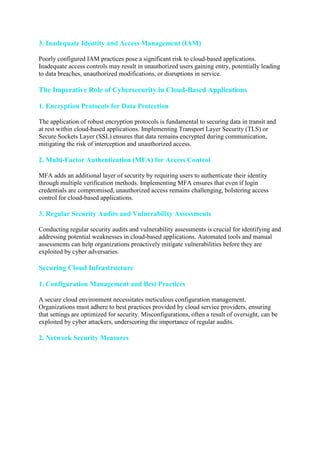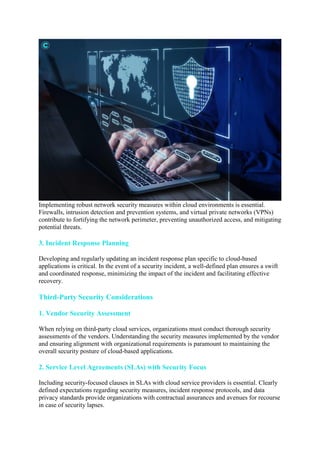Fortifying the Digital Sky: Exploring the Application of Cybersecurity for Cloud-Based Applications
- 1. Fortifying the Digital Sky: Exploring the Application of Cybersecurity for Cloud- Based Applications (Source – Allgeier secion) Cloud-Based Applications have become a key component of technical innovation in the dynamic world of modern computing, where scalability and agility are critical. Strong cybersecurity safeguards are becoming more and more important as enterprises move their core business processes to the cloud. This paper explores the topic of cloud-based applications, explains the complexities of their cybersecurity needs, and looks at the steps that are necessary to protect sensitive data and make sure that cloud-based infrastructures are resilient. Understanding Cloud-Based Applications: 1. Defining Cloud-Based Applications Cloud-Based Applications, often referred to as Software as a Service (SaaS), leverage cloud computing infrastructure to deliver software applications over the internet. Unlike traditional
- 2. software models, cloud-based applications eliminate the need for users to install, manage, or maintain the software locally. Instead, users access these applications through web browsers, enabling seamless collaboration, scalability, and enhanced flexibility. 2. Key Characteristics of Cloud-Based Applications Cloud-based applications exhibit distinctive characteristics that set them apart from traditional on-premises solutions. They are typically accessible from any device with internet connectivity, enabling remote access and facilitating collaboration across geographically dispersed teams. Additionally, these applications are scalable, allowing organizations to adapt their computing resources based on demand, optimizing efficiency and cost-effectiveness. The Vulnerabilities of Cloud-Based Applications 1. Data Exposure and Unauthorized Access The very nature of cloud-based applications, with data residing in remote servers, raises concerns about data exposure and unauthorized access. Cybercriminals may exploit vulnerabilities in the application or misconfigurations in cloud settings to gain unauthorized entry, potentially compromising sensitive information. 2. Data Interception and Eavesdropping As data travels between users and cloud servers, there is a risk of interception and eavesdropping. Without adequate encryption protocols, cyber adversaries may exploit vulnerabilities in network communication, leading to the unauthorized monitoring of data flows.
- 3. 3. Inadequate Identity and Access Management (IAM) Poorly configured IAM practices pose a significant risk to cloud-based applications. Inadequate access controls may result in unauthorized users gaining entry, potentially leading to data breaches, unauthorized modifications, or disruptions in service. The Imperative Role of Cybersecurity in Cloud-Based Applications 1. Encryption Protocols for Data Protection The application of robust encryption protocols is fundamental to securing data in transit and at rest within cloud-based applications. Implementing Transport Layer Security (TLS) or Secure Sockets Layer (SSL) ensures that data remains encrypted during communication, mitigating the risk of interception and unauthorized access. 2. Multi-Factor Authentication (MFA) for Access Control MFA adds an additional layer of security by requiring users to authenticate their identity through multiple verification methods. Implementing MFA ensures that even if login credentials are compromised, unauthorized access remains challenging, bolstering access control for cloud-based applications. 3. Regular Security Audits and Vulnerability Assessments Conducting regular security audits and vulnerability assessments is crucial for identifying and addressing potential weaknesses in cloud-based applications. Automated tools and manual assessments can help organizations proactively mitigate vulnerabilities before they are exploited by cyber adversaries. Securing Cloud Infrastructure 1. Configuration Management and Best Practices A secure cloud environment necessitates meticulous configuration management. Organizations must adhere to best practices provided by cloud service providers, ensuring that settings are optimized for security. Misconfigurations, often a result of oversight, can be exploited by cyber attackers, underscoring the importance of regular audits. 2. Network Security Measures
- 4. Implementing robust network security measures within cloud environments is essential. Firewalls, intrusion detection and prevention systems, and virtual private networks (VPNs) contribute to fortifying the network perimeter, preventing unauthorized access, and mitigating potential threats. 3. Incident Response Planning Developing and regularly updating an incident response plan specific to cloud-based applications is critical. In the event of a security incident, a well-defined plan ensures a swift and coordinated response, minimizing the impact of the incident and facilitating effective recovery. Third-Party Security Considerations 1. Vendor Security Assessment When relying on third-party cloud services, organizations must conduct thorough security assessments of the vendors. Understanding the security measures implemented by the vendor and ensuring alignment with organizational requirements is paramount to maintaining the overall security posture of cloud-based applications. 2. Service Level Agreements (SLAs) with Security Focus Including security-focused clauses in SLAs with cloud service providers is essential. Clearly defined expectations regarding security measures, incident response protocols, and data privacy standards provide organizations with contractual assurances and avenues for recourse in case of security lapses.
- 5. Data Privacy and Compliance in Cloud-Based Applications 1. Data Residency and Sovereignty Understanding the geographic location of cloud servers and the implications for data residency and sovereignty is crucial. Some jurisdictions have specific regulations governing the storage and processing of certain types of data, necessitating compliance considerations for cloud-based applications. 2. Compliance with Industry Standards Adhering to industry-specific compliance standards is imperative for organizations leveraging cloud-based applications. Whether it be healthcare, finance, or other sectors, compliance with standards such as HIPAA, PCI DSS, or GDPR ensures that data handling practices align with regulatory requirements. Continuous Monitoring and Adaptation: 1. Real-Time Monitoring for Anomaly Detection Implementing real-time monitoring solutions aids in the early detection of anomalous activities within cloud-based applications. Unusual patterns or behaviors may indicate potential security threats, allowing organizations to respond swiftly and proactively. 2. Adaptive Security Measures
- 6. Recognizing the dynamic nature of cyber threats, organizations must adopt adaptive security measures. This involves staying abreast of emerging threats, updating security protocols accordingly, and fostering a culture of continuous improvement to stay ahead of evolving cybersecurity challenges. Conclusion: Safeguarding the Digital Horizon The security of cloud-based apps becomes crucial in the age of cloud computing because the cloud’s virtual expanse defines the horizon. The mutually beneficial relationship between cybersecurity and cloud computing emphasizes the necessity of taking preventative action to strengthen digital infrastructures against a dynamic threat landscape. A strong defence against possible cyber attackers is created by putting encryption protocols, access controls, and strong network security into place together with strict adherence to compliance guidelines and ongoing monitoring. The rising adoption of cloud-based apps by organizations places a responsibility on cybersecurity experts and decision-makers to give security measures top priority. By fostering a comprehensive cybersecurity strategy tailored to the unique challenges of cloud environments, businesses can harness the full potential of cloud-based applications while safeguarding the integrity, confidentiality, and availability of their digital assets. In this digital age, where the cloud is both a catalyst for innovation and a repository of critical data, the fusion of robust cybersecurity practices and cloud-based application development defines the path to a secure and resilient digital future.






